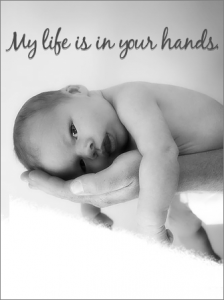Don’t Look: Look Closely: Abortion and Anti-Choice Aesthetics (Part 2)
 In Part 1, we looked at viscerally upsetting anti-choice images, the ones waved on banners and looking down from billboards, but there is another set of images that operate differently. With this other set you feel more respected as a viewer– you are being invited to the discussion, not scared away from it. If the gory images are intimidating, these are purposely pathetic. This visual rhetorical strategy operates in photos of very pregnant women looking upset, photos of babies smiling, and even fetuses smiling in utero. They are the pictures that so often accompany the phrase, “It’s a child, not a choice.”
In Part 1, we looked at viscerally upsetting anti-choice images, the ones waved on banners and looking down from billboards, but there is another set of images that operate differently. With this other set you feel more respected as a viewer– you are being invited to the discussion, not scared away from it. If the gory images are intimidating, these are purposely pathetic. This visual rhetorical strategy operates in photos of very pregnant women looking upset, photos of babies smiling, and even fetuses smiling in utero. They are the pictures that so often accompany the phrase, “It’s a child, not a choice.”
The change in tactic is important. Bloody photos are tools of heavy-handed manipulation, while these other images, appropriate for a magazine advert or doctor’s office pamphlet, are more palatable and not immediately offensive. As opposed to the confrontational nature of the violent images, pregnant women and babies are wholly non-threatening. They engender a sense of comfort, even if the concomitant messages make us very uncomfortable.
 In the white box mental space this time hangs a portrait of a happy baby. Next to it perhaps is a woman, in an advanced state of pregnancy, holding the hand of an older child (maybe 5 or 6). A third, in this curated brain space, could be a 3D image of a fetus’s face, in terra cotta tones, with its hand held up to its face. While each piece works a little differently, they all rely fundamentally on the same sleight of hand: we are assured that none of the pictured people will abort, and none of the fetuses are going to be aborted. It might seem painfully oversimplified, but that’s why its dishonesty is insidiously effective. The ads imply that abortion kills grown children and pregnant women, not fetuses. Why is it necessary to use visual stand-ins and substitutes?
In the white box mental space this time hangs a portrait of a happy baby. Next to it perhaps is a woman, in an advanced state of pregnancy, holding the hand of an older child (maybe 5 or 6). A third, in this curated brain space, could be a 3D image of a fetus’s face, in terra cotta tones, with its hand held up to its face. While each piece works a little differently, they all rely fundamentally on the same sleight of hand: we are assured that none of the pictured people will abort, and none of the fetuses are going to be aborted. It might seem painfully oversimplified, but that’s why its dishonesty is insidiously effective. The ads imply that abortion kills grown children and pregnant women, not fetuses. Why is it necessary to use visual stand-ins and substitutes?
Because it is difficult to emotionally connect with images of fetuses. When photographed without embellishment, a picture of a fetus is almost always too medical to produce the sympathy required to motivate a viewer to engage in any new system of politics. This is the reason, moreover, that “partial birth abortion” is a heavily endorsed buzz-phrase. Statistically, 0% of abortions are “partial birth” every year, and the tiny percentage of abortions that do occur in the third trimester– that time when a fetus becomes a baby, visually and legally speaking– happen for reasons of severe fetal deformations or disorders, or imminent harm to the woman carrying the child. That is to say, when women are present in anti-choice images, they are usually very pregnant, and that is not what a woman who wants an abortion looks like. The solemnity with which anti-choice groups treat abortion lends those visual substitutes gravitas that they don’t deserve. That is to say, the insistence on the no-nonsense, “Think of the children!” nature of abortion allows these images to get away with a visual prestidigitation unnoticed and unpenalized. It’s deceit under the auspices of an incorruptible motivation.
 What are we looking at when we browse this mental gallery, then? The images are of individual entities, but they are about family. It’s a narrative leap that the viewer is expected to make, and the leap feels so natural that pointing out the visual substitutions almost seems too finicky, even hypercritical. Which is the sign of a truly excellent, seductive ad campaign. When the images double as advertisements, the viewer is absolutely being sold something.
What are we looking at when we browse this mental gallery, then? The images are of individual entities, but they are about family. It’s a narrative leap that the viewer is expected to make, and the leap feels so natural that pointing out the visual substitutions almost seems too finicky, even hypercritical. Which is the sign of a truly excellent, seductive ad campaign. When the images double as advertisements, the viewer is absolutely being sold something.
If we viewers encounter an advertising campaign for an energy drink or body wash, we might roll our eyes and accept that advertising sells exaggerations and connotations, and sometimes outright lies, so why is this any different? Why is it important to analyze anti-choice imagery when we know that of course they, like everyone else, are trying to sell us something? Because there is no self-aware wink to these pictures. They seem to present god’s own truth about women and children, and it is blasphemous to joke about or belittle the sanctity of human creation. Viewers are expected to take their visual information as holy truth. But anti-choice ads are as carefully constructed as any other kind of ad. They provoke an immediate emotional response that makes it difficult for the viewer to step back and realize that the images are false, if convincing, visual tricks. Our white-box exercise is a vital step in dissecting and analyzing the narrative of anti-choice images.



Dilettante Mail
Get updates from us a few times a year.